The Effect of Motion Pictures on the Social Attitudes of High School Children
Chapter 4
Ruth C. Peterson and L. L. Thurstone
Table of Contents | Next | Previous
Chapter IV
The experiments reported have been concerned with the measurement of the effect of a motion picture on social attitudes. The effect of a motion picture was measured by means of an attitude scale given a week or two before and the day after the film was shown. These measurements of the immediate effect of a film showed, in a number of experiments, very striking changes in attitude. We were interested in studying the persistence of the effect by repeated measurement of the attitudes of the children who had participated in the experiments. We present below the results of six studies of the persistence of the effect of a motion picture.
In Genoa, Illinois, the experiment conducted showed a change of attitude favorable to the Germans, as the result of seeing the film "Four Sons"' As previously reported the effect of the motion picture was measured the day after the children saw the film. After an interval of six months, the scale of attitude. toward the Germans was given again. The group included 87 of the students who had seen the picture. The mean attitude of this group on April 17, 1930 was 5.66; the day after the picture was shown (April 29, 1950) it was 5.19; about six months later (October 9, 1930) the mean attitude of the group was 5.10. In other words, the children were still more favorable to the Germane six months later than they were the day after they saw the film "Four Sons." We suggest as an explanation the fact that there was no theatre in Genoa regularly showing pictures and that the motion picture "Four Sons" was probably the subject of considerable comment and discussion among the children because a motion picture was a relatively rare occurrence for this group. Figure 30 gives the three frequency distributions. The statistical facts for each distribution re given below the figure.
( 54)
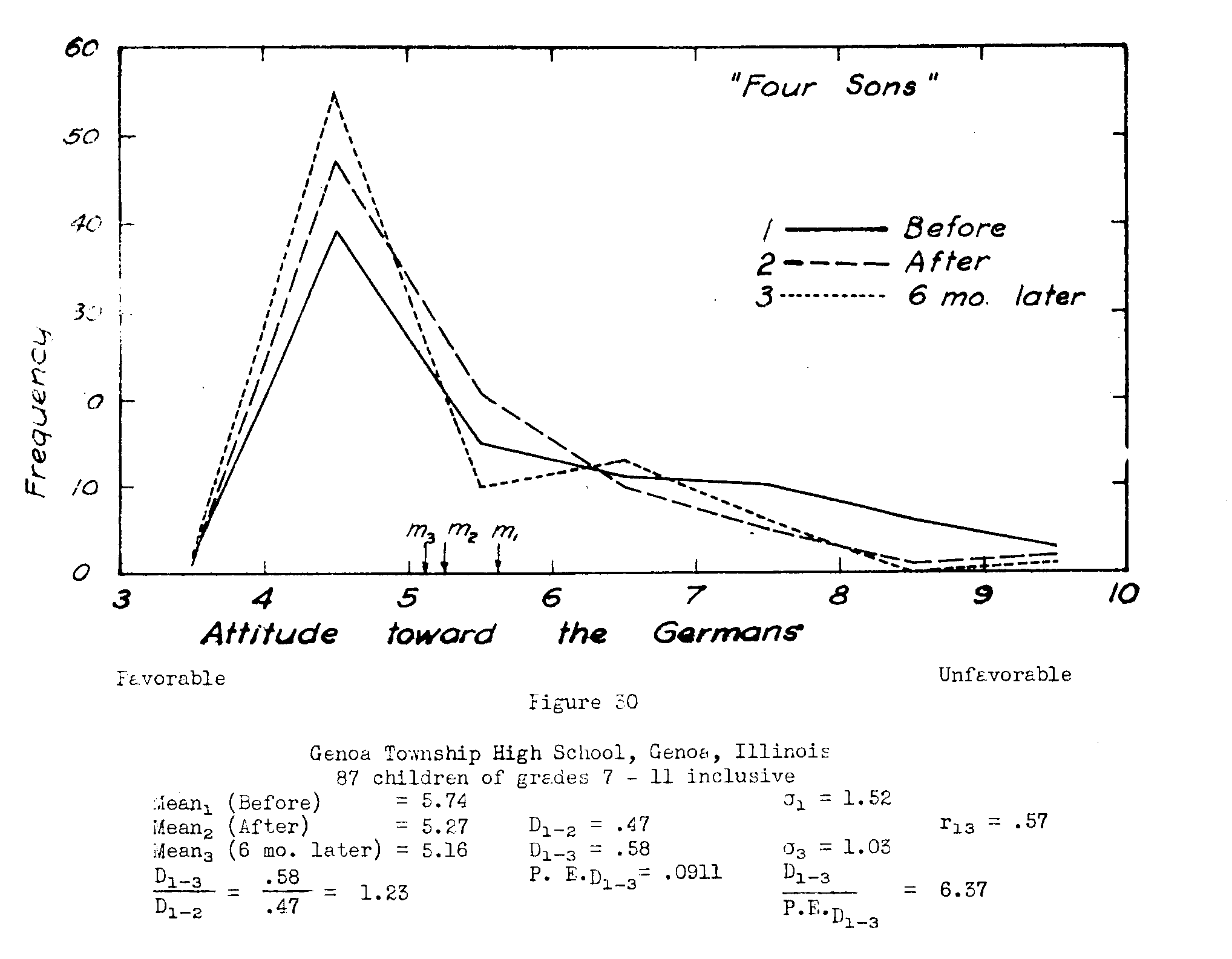
The paired comparison schedule of nationalities was also repeated, and the results showed the Germans in the same relative position (see figure 2) six months later that they were the day after the children saw the motion picture "Four Sons".
In Geneva where the motion picture "Son of the Gods" was shown and its effects on the high school students' attitudes toward the Chinese measured, the scale of attitude toward the Chinese was given again after an interval of five months, and a fourth tine after an interval of nineteen month. The means of the group before and after were recalculated including only the students {117) who took. the scale the third time. Consequently these means vary slightly from those reported for; the original group.
Figure 31 shows the frequency distributions for the group the week before, the day after seeing the film "Son of the Gods", and five months later. The three means are as follows: before 6.57, after 5.26, five months later 5.76. The third measurement shows that the attitudes of the children toward the Chinese had returned part way toward the position before the picture was seen, but the children were still decidedly more favorable toward the Chinese than they had been five months previously, before the
(55) film was shown. The Statistical facts about the three distributions are given below the figure.
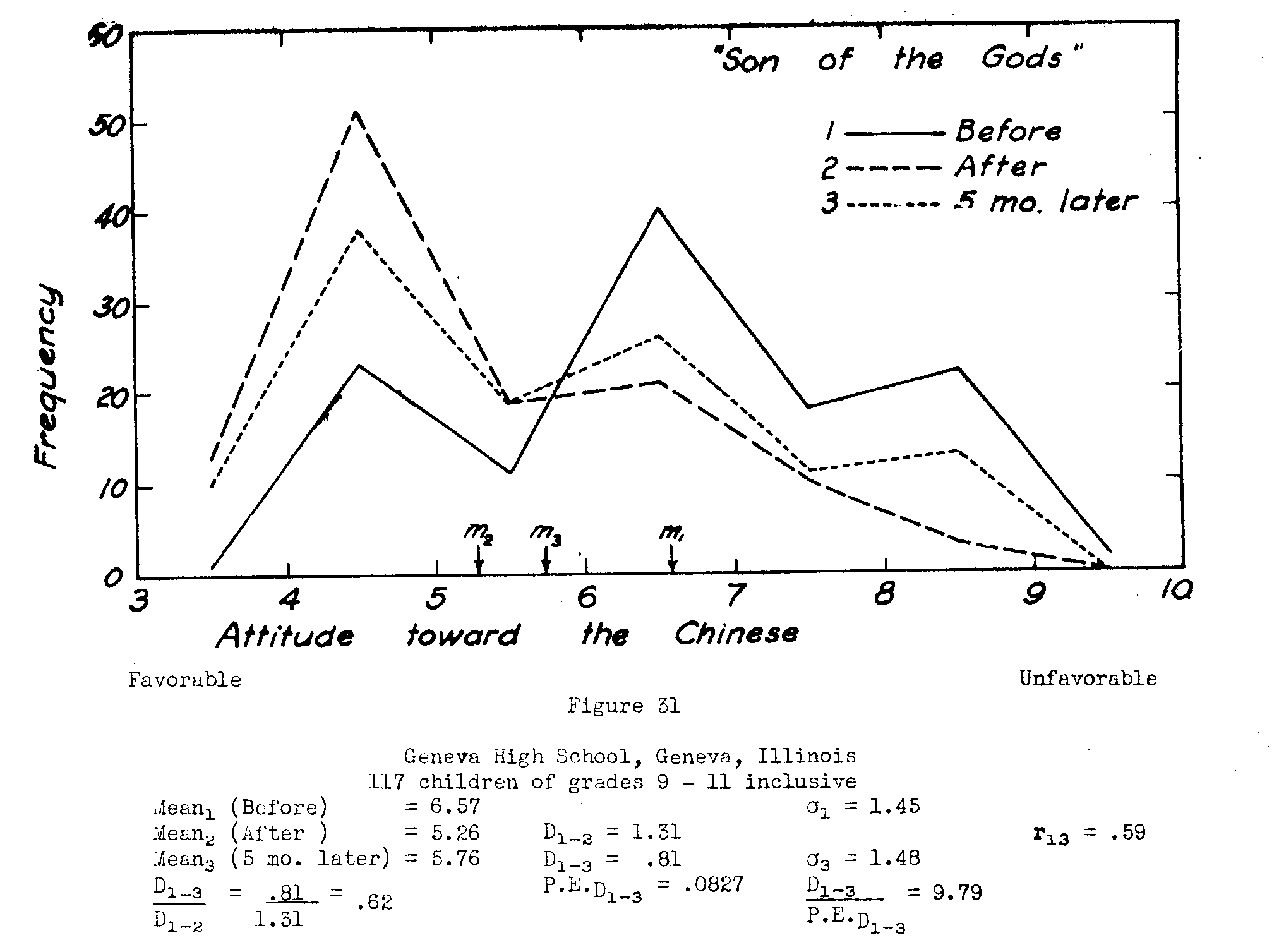
The difference five months later (.81) divided by the difference measured the day following the presentation of the motion picture (1.31) gives a ratio of .62. We may say that the effect of the film was still definitely present after the interval of five months.
The scale of attitude toward the Chinese was given in the Geneva High School again in the fall of 1931, nineteen months after the original experiment was conducted. The group was much smaller, because two classes had graduated, but a comparison of the four means for the. 76 students who had participated in the original experiment and who were still available shows that the children's attitudes, after an interval of over a year and a half, still showed the effect of the film "Son of the Gods". The means were as follows:

( 56)
The data indicate that the effect of the film "Son of the Gods" is present after an interval of 19 months. The children's attitudes are still, after that interval, definitely more favorable to the Chinese than previous to the viewing of the film. The change in attitude from October, 1950 to December, 1931 shows very little return toward the original position as measured on May 17, 1930. The effect of the picture on attitude, as measured the day after the picture was seen, has been partially lost after an interval of 5 months. The loss during the succeeding 14 months is, however, very small, as indicated by the ratios given above.
It may be noted that the difference Μ1 - M2 is larger for this group of 76 than for the group of 117 who participated in the first measurement of persistence. The ratio of Μ1 - Μ3 to Μ1 - Μ2 is comparable for the two groups, however, indicating that the percentage of the original effect which was still present was practically the same, although the absolute change varied for the two groups.
The paired comparison of minor crimes was given a third time at Mendota, Illinois, to study the persistence of the effect of "Street of Chance" on the children's attitudes toward gambling. .
The schedule was given on May 15, 1930, the motion picture was shown on May 22, the scale was given the second time on May 23, and five months later on October 15, 1930.
Figure 32 shows the scale values for each crime before, after, and five months later. The scale value for gambler, which changed markedly after the children had seen the film, returned part way toward its first position, but the effect of the film is still evident.
( 57)
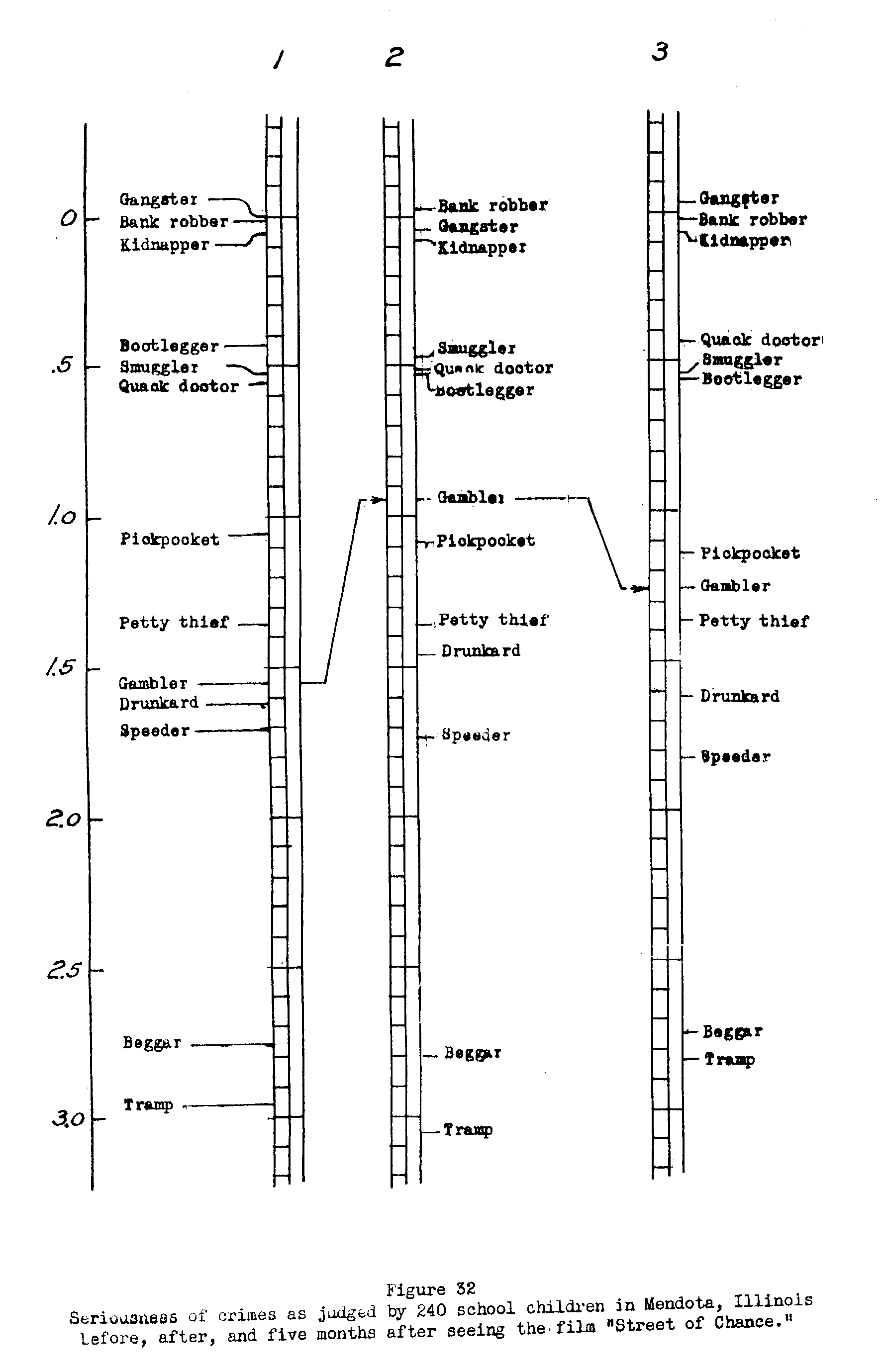
( 58)
In Watseka, Illinois, the scale of attitude toward punishment of criminals, which had been used to measure the effect of the picture "The Criminal Code", was given twice more after intervals of two and one-half months and nine months, respectively.
In figure 33 the frequency distributions before and after and two and one-half months later are given. The means for the three distributions are 5.33, 4.78, and 4.85 respectively. The effect of the motion picture on the children's attitudes toward the punishment of criminals is still very evident after the interval of two and one-half months.
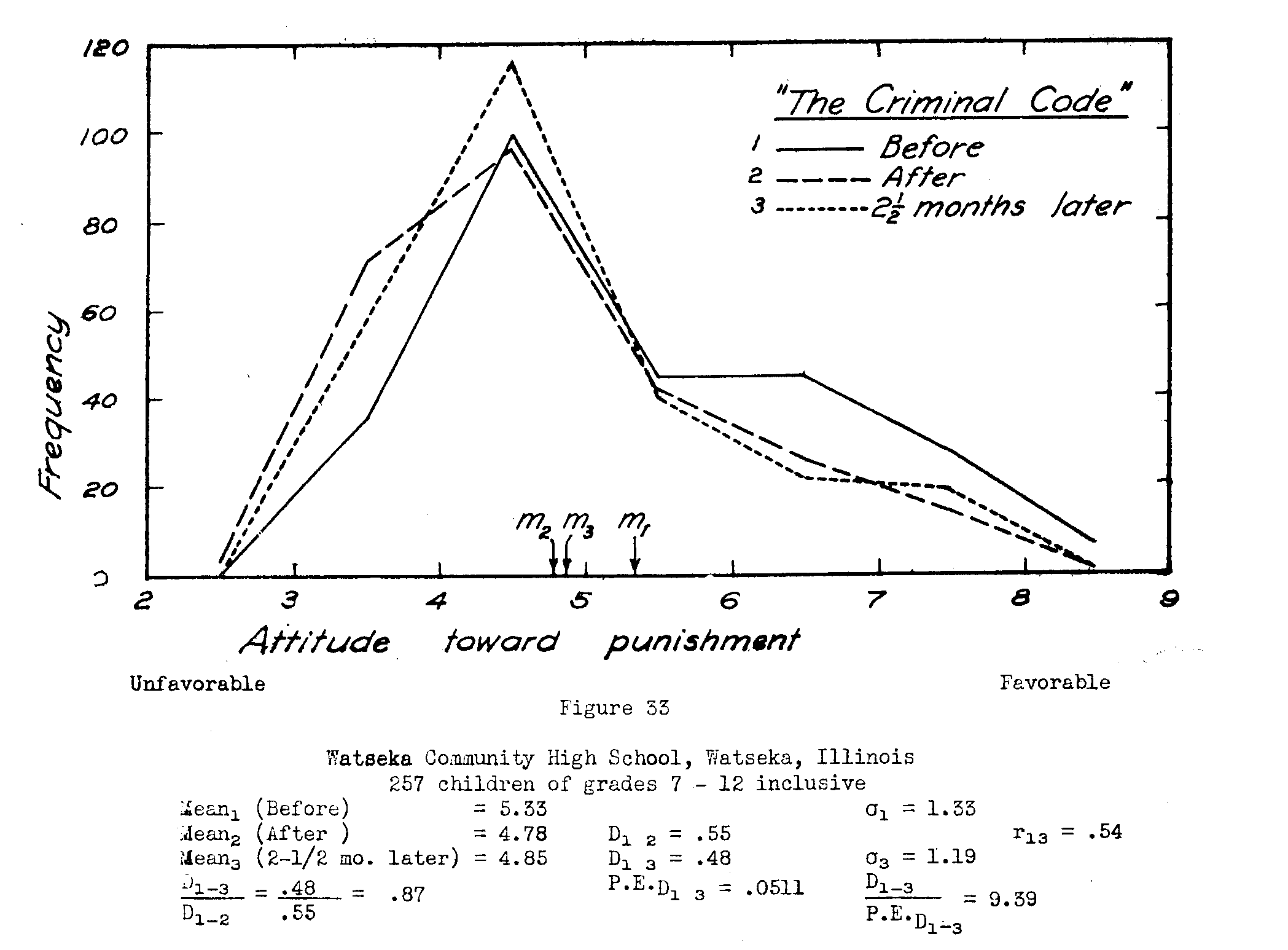
The scale was given the fourth time in December, 1931. 195 children who had participated in the experiment took the scale. The means for this group in each of the four applications appear below.

(59)
It is obvious that the effect of the motion picture was present nine months after the children saw the film. 88% of the effect measured the day after the picture was still present after ten weeks; after nine months 78% of the effect remained. We conclude that the effect of this motion picture on attitude persists for a considerable period of time, and although the effect is smaller after an interval, it is still very evident.
In Paxton, Illinois, we found that the film "All Quiet on the Western Front" made the children less favorable to war. The experiment was conducted in March, 1951. In November, 1951, nine months later, the scale of attitude toward war was given again.
The change in attitude as a result of the picture was .60 of a scale step, a change in the direction of pacíficísm. The ratio of the difference to the P.E.D was 13.2 which was undοubtedly a significant change. The mean attitude of the group eight months later was 4.64, a change in the opposite direction. The difference between M1 and M3 was .30 scale step in the direction favorable to war. The change of attitude represented by the difference between M4 and M3 was .90 scale step in the direction favorable to war. The three frequency distributions for the group of 138 students are given in figure 34.
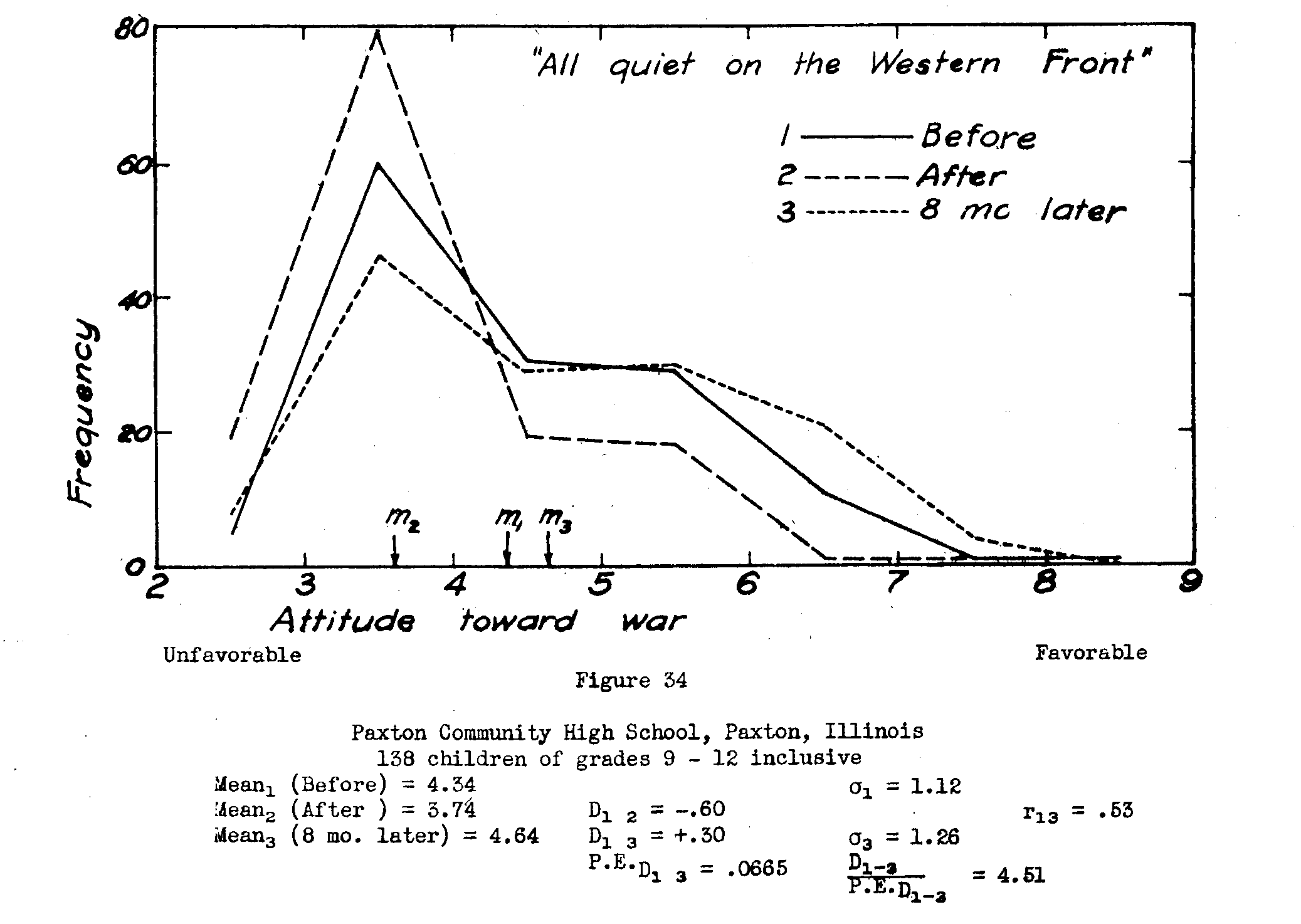
( 60)
We have no explanation for this effect. There was, undoubtedly, some interposed propaganda which made the children more favorable toward war. We are trying to discover whether anything happened in the community during the interval between March and November, 1931, which might explain the fact that the children's attitudes were more favorable to war at the third measurement in November than they were in March, in spite of the fact that the interposed film had a significant effect on their attitudes in the opposite direction. The change is obviously too large to be attributed to chance error in measurement.
In the study reported earlier in this paper we found that the picture "The Birth of a Nation" had a striking effect on the attitudes of a group of children toward the negro. The scale of attitude toward the negro which had been given on day 18, 1931 (before the picture) and May 27, 1931 (the day after the picture) was given again on October 20, 1931.
Figure 35 gives the three frequency distributions. The statistical facts for the three distributions are given below.
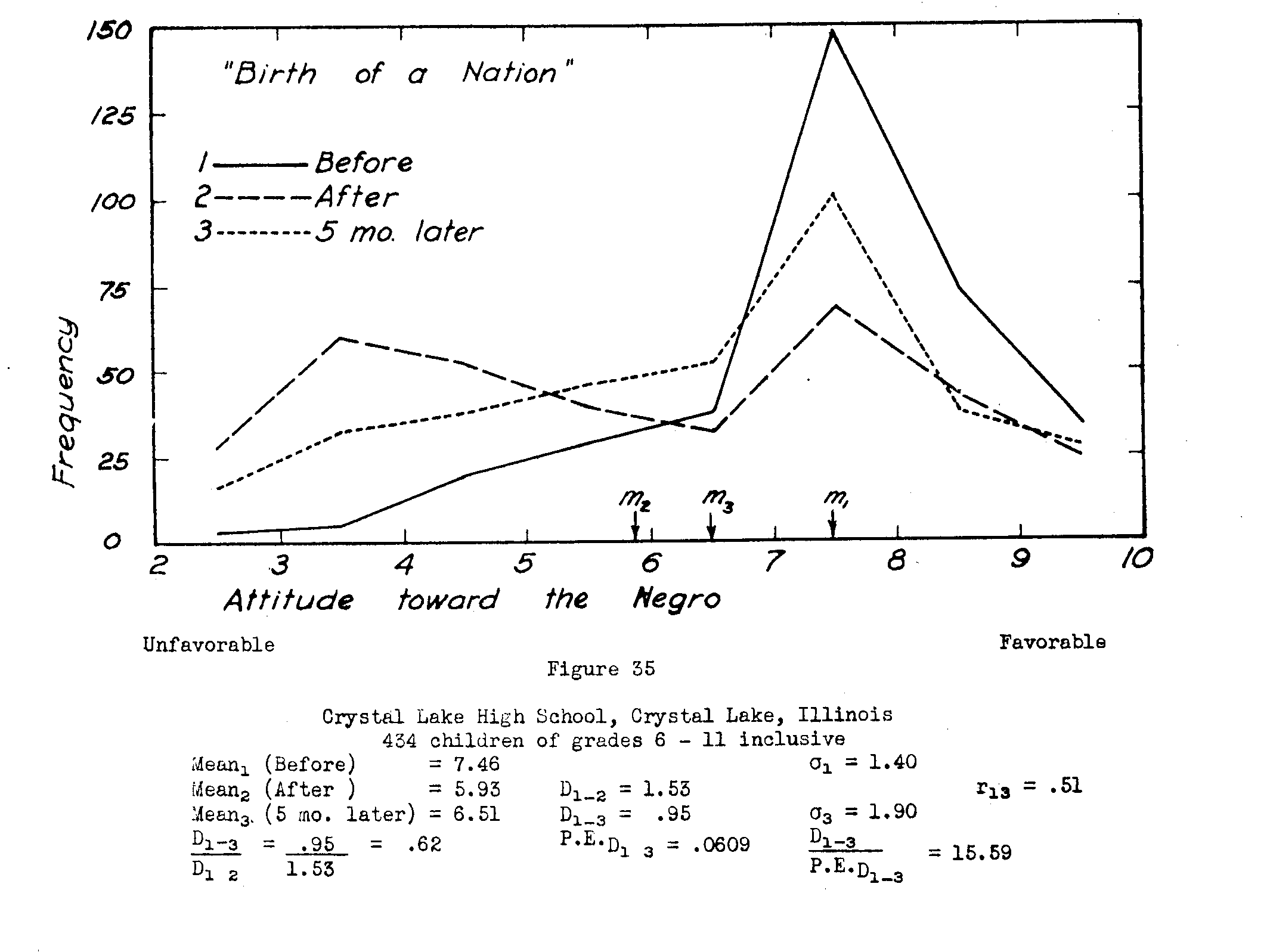
( 61)
If the three means are compared, it may be noted that the mean attitude of the group five months after the picture was shown was much less favorable to the negro than before the picture was seen. Although the attitudes of the group had returned part way toward the position represented by the first distribution of attitude, the effect of the picture "The Birth of a Nation" on the children's attitudes toward the negro was still definitely present eight months after the film was shown.
We conclude that the effect of motion pictures on children's attitudes, measured by means of attitude scales given a week or two weeks before and the day following the presentation of the film, persists for a considerable period of time. The measurements of persistence which have been presented indicate in each case, with the exception of Paxton, that the change in attitude occasioned by a motion picture is lasting. The table below summarizes the amount of the effect measured which is present after various intervals.
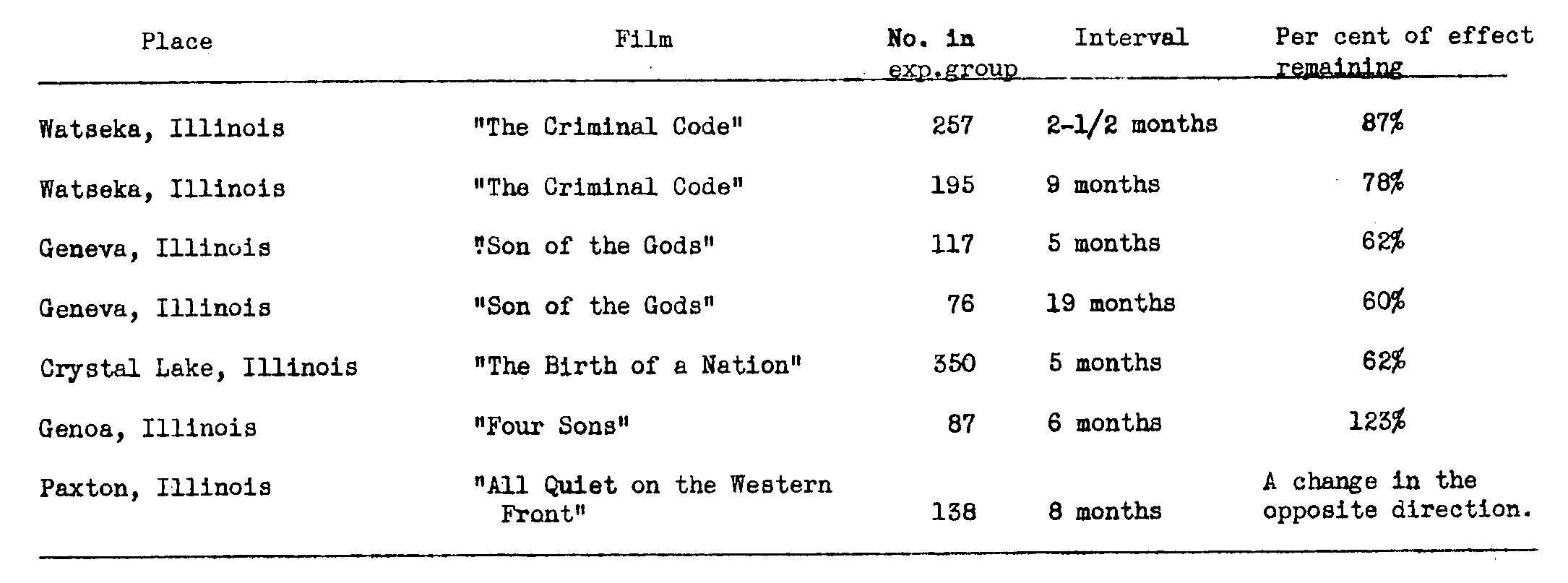
This summary is presented without regard to the amount of change as a result of the picture but is given to show that the effects found are very definitely lasting. The longest interval between an original measurement of attitude and a measurement of the persistence of a change in attitude as a result of seeing a motion picture is 19 months; the data presented indicate, however, that the effect of a motion picture on social attitudes probably persists for a much longer time.